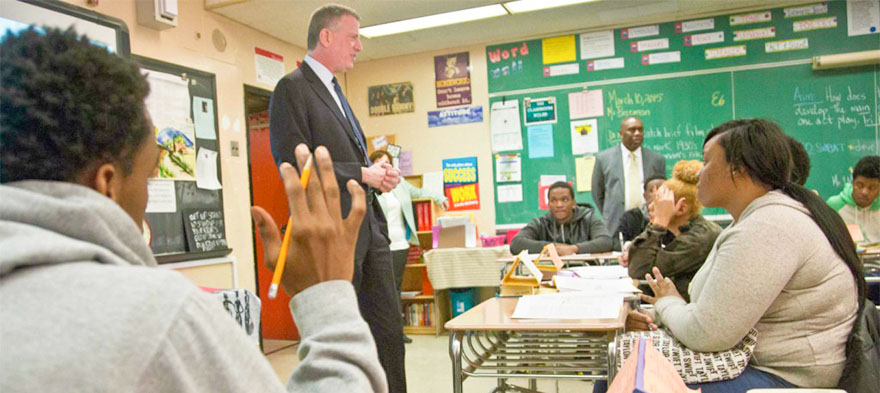
Oct 28, 2016 12:00:00 AM
by Laura Waters
Two years in, at these and others of the lowest-performing high schools in the program, academic progress is hard to see. At many of them, dwindling enrollment and internal conflicts make the prospect that they will succeed seem remote.Others complain that the goals set for these schools are absurdly low. As Merryl Tisch, former chair of the Board of Regents, told Chalkbeat, [pullquote position="right"]“at some point, everyone has to stop being ridiculous.”[/pullquote] A recent Daily News analysis found that 33 Renewal Schools showed gains in student proficiency, 29 schools remained stable, and 32 schools showed decreases in student achievement. Not much to write home about. Eva Moskowitz, founder of Success Academy charter schools, tweeted (tartly but accurately), “progress at Renewal Schools is hard to see because there has been none. NYC schools crisis continues.”
“Families are pulling their children out of these schools,” contends Jenny Sedlis, Executive Director of StudentsFirstNY, “because the mayor’s misguided approach isn’t working. City Hall has poured millions of taxpayer dollars into his Renewal School program and designated them “community schools”—meaning, in part, they’ll qualify for washing machines and dryers. That’s great, but chronically struggling schools need a real turnaround plan that focuses on actually boosting academic achievement. She continues,One of the steepest drops came at the school where the mayor announced his turnaround plan with great fanfare. Coalition School for Social Change in East Harlem had 283 teenagers when the mayor called it a model for reform in November 2014. Last month it had 174.
The stark reality is that district schools are failing their students, and parents want better options. And while performance at Renewal Schools continues to lag, charter schools serving the same communities are far outperforming traditional district schools.
[An analysis by] The Post revealed that chronic absenteeism rates were much higher than Fariña had claimed, and the city now says the actual absentee rate is just under 40 percent.The city scrambled to write off this huge discrepancy as a clerical error. In reality, it’s just another example of the de Blasio administration cooking the books on the progress, integrity and safety of city district schools. Unless the comptroller, public advocate or state Education Department quickly decides to conduct a thorough audit of the Department of Education, students, parents and teachers are at risk of losing an entire school year to this kind of deception.
If he doesn’t see a difference between the schools in our richest areas and the schools in our poorest areas, then Mayor de Blasio is living in a Gracie Mansion fantasy land. Maybe it’s true for your neighborhood, Mr. Mayor, that all the schools are good, but it’s not true for kids in the Bronx.There are bad schools. Cerf owns that in Newark. You need to own it in New York City: after all, that's the justification for the Renewal Schools Program. But a one-pronged strategy can't begin to address the concerns of parents like Ms. Moore-Willis, who are tired of pablum and desperate for bold and coherent change. Are you up to the task? Can you up your game? Can you augment your toolbox? Your final grade depends on you.
Laura Waters is the founder and managing editor of New Jersey Education Report, formerly a senior writer/editor with brightbeam. Laura writes about New Jersey and New York education policy and politics. As the daughter of New York City educators and parent of a son with special needs, she writes frequently about the need to listen to families and ensure access to good public school options for all. She is based in New Jersey, where she and her husband have raised four children. She recently finished serving 12 years on her local school board in Lawrence, New Jersey, where she was president for nine of those years. Early in her career, she taught writing to low-income students of color at SUNY Binghamton through an Educational Opportunity Program.
The story you tell yourself about your own math ability tends to become true. This isn’t some Oprah aphorism about attracting what you want from the universe. Well, I guess it kind of is, but...
If you have a child with disabilities, you’re not alone: According to the latest data, over 7 million American schoolchildren — 14% of all students ages 3-21 — are classified as eligible for special...
The fight for educational equity has never been just about schools. The real North Star for this work is providing opportunities for each child to thrive into adulthood. This means that our advocacy...
Your donations support the voices who challenge decision makers to provide the learning opportunities all children need to thrive.
Ed Post is the flagship website platform of brightbeam, a 501(c3) network of education activists and influencers demanding a better education and a brighter future for every child.
© 2020–2024 brightbeam. All rights reserved.
Leave a Comment